MBS662: Critical Analysis of Supply Chain, Society, and Environment
VerifiedAdded on 2022/11/25
|12
|3062
|180
Report
AI Summary
This report delves into the critical aspects of supply chain management, focusing on the creation of shared value, societal impacts, and environmental considerations within the context of the MBS662 course. It examines the evolution of business practices, contrasting Corporate Social Responsibility (CSR) with Corporate Shared Value (CSV), and analyzing the role of stakeholders, including governments and civil society organizations. The analysis draws upon readings from Porter & Kramer (2011), Pfitzer, Bockstette, & Stamp (2013), and others, exploring how businesses can integrate social and environmental benefits into their core strategies. The report discusses ethical supply chains, value alignment, and the challenges of global sustainability, referencing real-world examples like Walmart and the fast fashion industry. It also explores the impact of decision-making processes, government regulations, and the role of technology and innovation in achieving sustainable development goals, including the 2030 agenda. The report concludes with a discussion on the importance of ethical values, the complexities of shared value reporting, and the need for future research to connect sustainability and innovation in the business world.
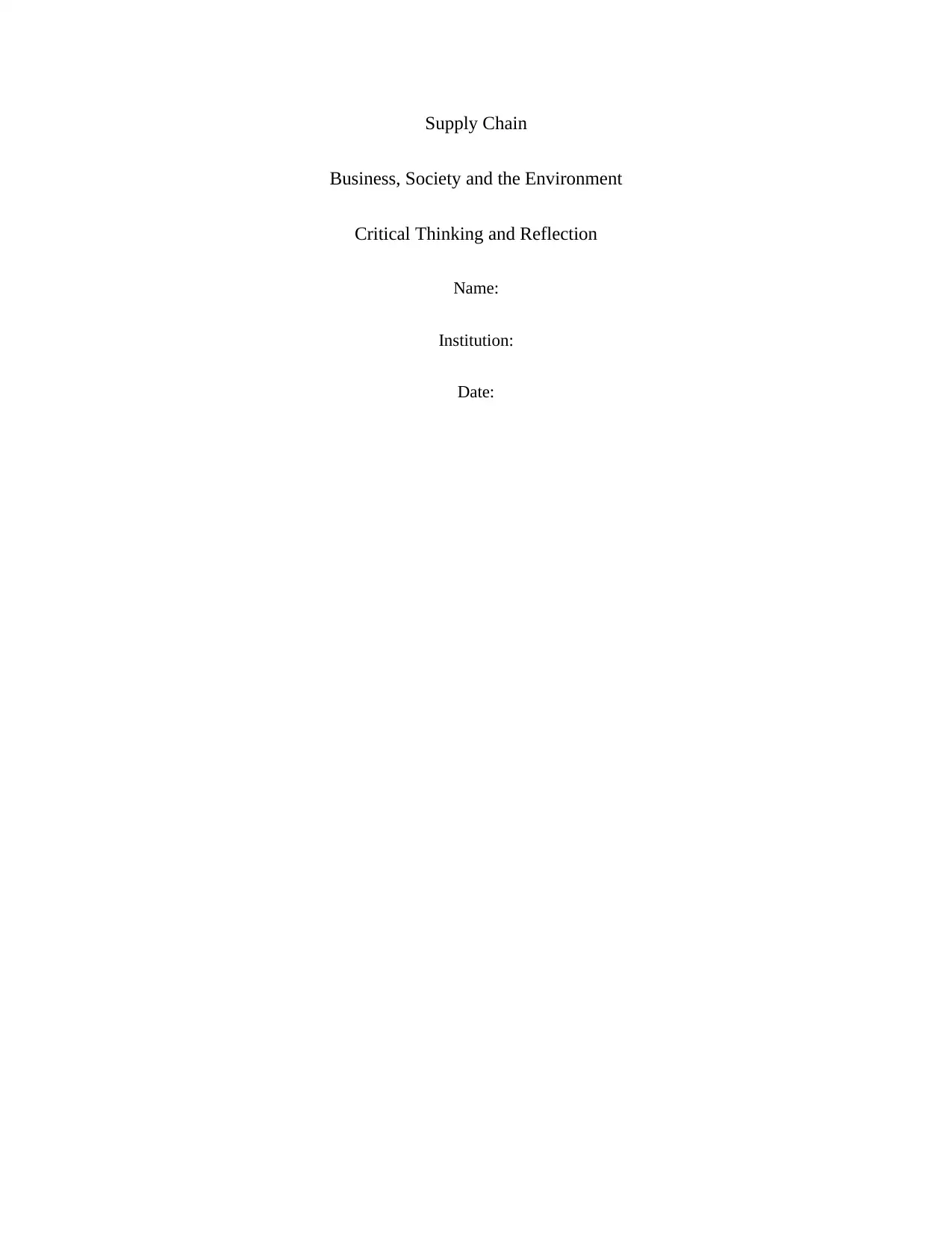
Supply Chain
Business, Society and the Environment
Critical Thinking and Reflection
Name:
Institution:
Date:
Business, Society and the Environment
Critical Thinking and Reflection
Name:
Institution:
Date:
Paraphrase This Document
Need a fresh take? Get an instant paraphrase of this document with our AI Paraphraser
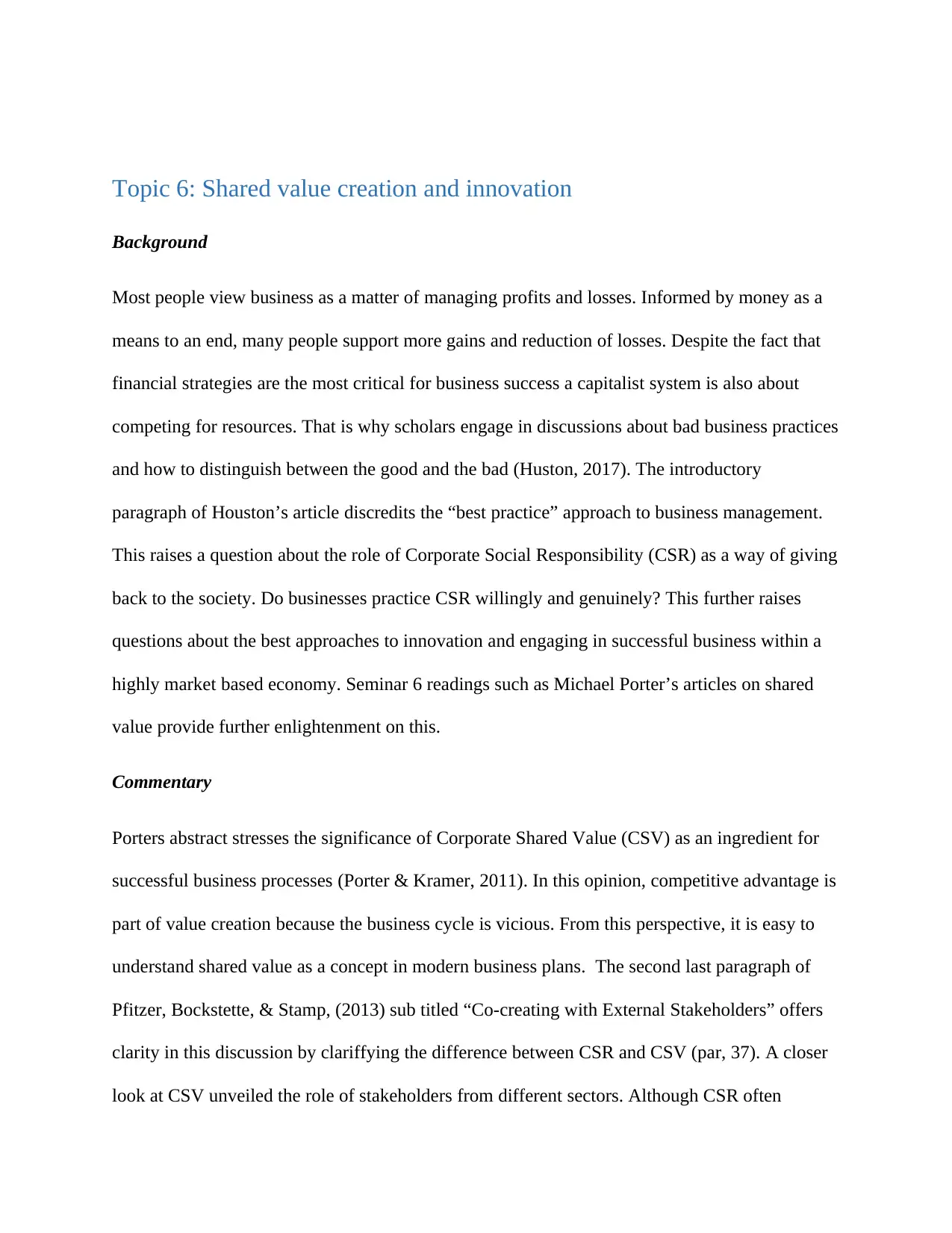
Topic 6: Shared value creation and innovation
Background
Most people view business as a matter of managing profits and losses. Informed by money as a
means to an end, many people support more gains and reduction of losses. Despite the fact that
financial strategies are the most critical for business success a capitalist system is also about
competing for resources. That is why scholars engage in discussions about bad business practices
and how to distinguish between the good and the bad (Huston, 2017). The introductory
paragraph of Houston’s article discredits the “best practice” approach to business management.
This raises a question about the role of Corporate Social Responsibility (CSR) as a way of giving
back to the society. Do businesses practice CSR willingly and genuinely? This further raises
questions about the best approaches to innovation and engaging in successful business within a
highly market based economy. Seminar 6 readings such as Michael Porter’s articles on shared
value provide further enlightenment on this.
Commentary
Porters abstract stresses the significance of Corporate Shared Value (CSV) as an ingredient for
successful business processes (Porter & Kramer, 2011). In this opinion, competitive advantage is
part of value creation because the business cycle is vicious. From this perspective, it is easy to
understand shared value as a concept in modern business plans. The second last paragraph of
Pfitzer, Bockstette, & Stamp, (2013) sub titled “Co-creating with External Stakeholders” offers
clarity in this discussion by clariffying the difference between CSR and CSV (par, 37). A closer
look at CSV unveiled the role of stakeholders from different sectors. Although CSR often
Background
Most people view business as a matter of managing profits and losses. Informed by money as a
means to an end, many people support more gains and reduction of losses. Despite the fact that
financial strategies are the most critical for business success a capitalist system is also about
competing for resources. That is why scholars engage in discussions about bad business practices
and how to distinguish between the good and the bad (Huston, 2017). The introductory
paragraph of Houston’s article discredits the “best practice” approach to business management.
This raises a question about the role of Corporate Social Responsibility (CSR) as a way of giving
back to the society. Do businesses practice CSR willingly and genuinely? This further raises
questions about the best approaches to innovation and engaging in successful business within a
highly market based economy. Seminar 6 readings such as Michael Porter’s articles on shared
value provide further enlightenment on this.
Commentary
Porters abstract stresses the significance of Corporate Shared Value (CSV) as an ingredient for
successful business processes (Porter & Kramer, 2011). In this opinion, competitive advantage is
part of value creation because the business cycle is vicious. From this perspective, it is easy to
understand shared value as a concept in modern business plans. The second last paragraph of
Pfitzer, Bockstette, & Stamp, (2013) sub titled “Co-creating with External Stakeholders” offers
clarity in this discussion by clariffying the difference between CSR and CSV (par, 37). A closer
look at CSV unveiled the role of stakeholders from different sectors. Although CSR often
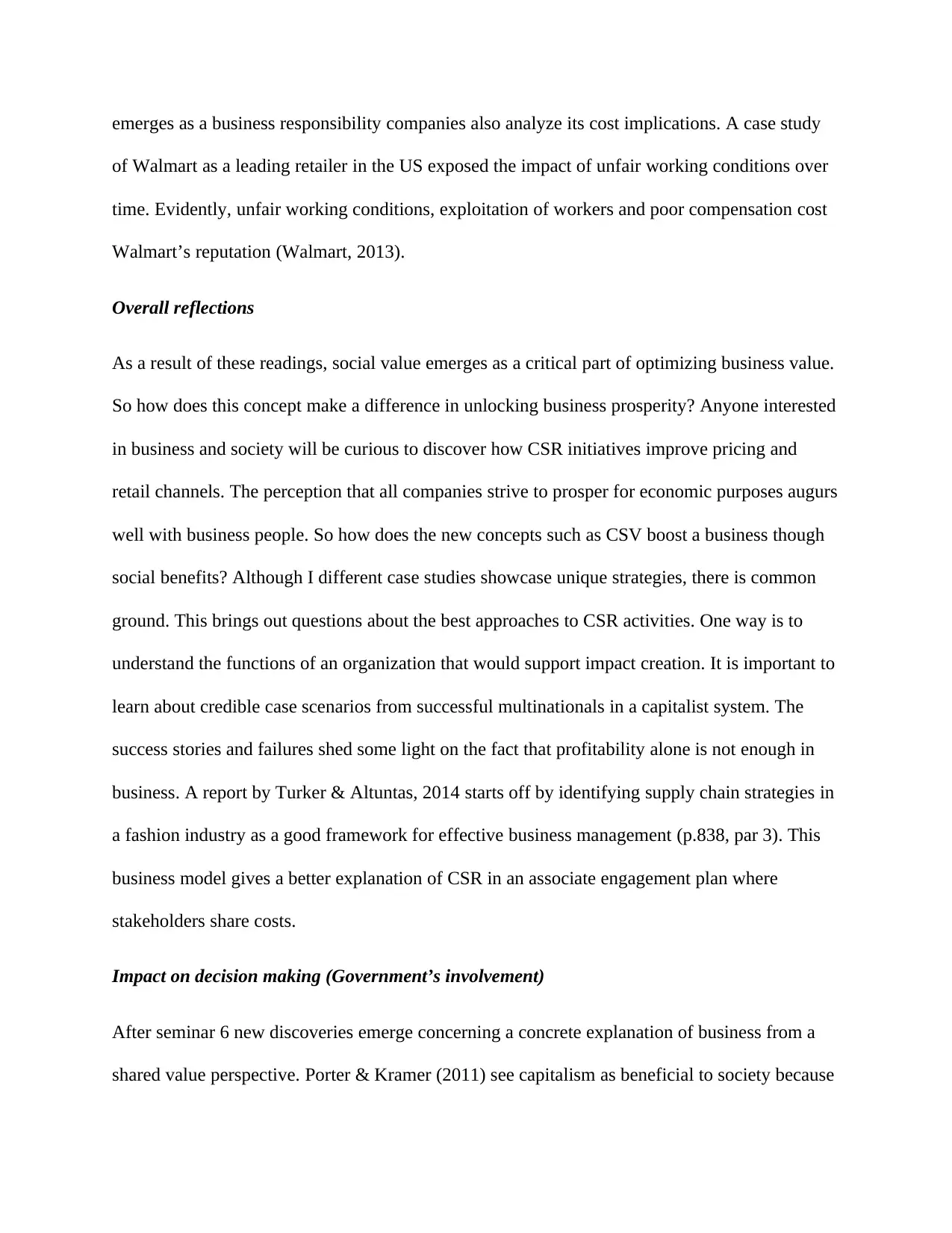
emerges as a business responsibility companies also analyze its cost implications. A case study
of Walmart as a leading retailer in the US exposed the impact of unfair working conditions over
time. Evidently, unfair working conditions, exploitation of workers and poor compensation cost
Walmart’s reputation (Walmart, 2013).
Overall reflections
As a result of these readings, social value emerges as a critical part of optimizing business value.
So how does this concept make a difference in unlocking business prosperity? Anyone interested
in business and society will be curious to discover how CSR initiatives improve pricing and
retail channels. The perception that all companies strive to prosper for economic purposes augurs
well with business people. So how does the new concepts such as CSV boost a business though
social benefits? Although I different case studies showcase unique strategies, there is common
ground. This brings out questions about the best approaches to CSR activities. One way is to
understand the functions of an organization that would support impact creation. It is important to
learn about credible case scenarios from successful multinationals in a capitalist system. The
success stories and failures shed some light on the fact that profitability alone is not enough in
business. A report by Turker & Altuntas, 2014 starts off by identifying supply chain strategies in
a fashion industry as a good framework for effective business management (p.838, par 3). This
business model gives a better explanation of CSR in an associate engagement plan where
stakeholders share costs.
Impact on decision making (Government’s involvement)
After seminar 6 new discoveries emerge concerning a concrete explanation of business from a
shared value perspective. Porter & Kramer (2011) see capitalism as beneficial to society because
of Walmart as a leading retailer in the US exposed the impact of unfair working conditions over
time. Evidently, unfair working conditions, exploitation of workers and poor compensation cost
Walmart’s reputation (Walmart, 2013).
Overall reflections
As a result of these readings, social value emerges as a critical part of optimizing business value.
So how does this concept make a difference in unlocking business prosperity? Anyone interested
in business and society will be curious to discover how CSR initiatives improve pricing and
retail channels. The perception that all companies strive to prosper for economic purposes augurs
well with business people. So how does the new concepts such as CSV boost a business though
social benefits? Although I different case studies showcase unique strategies, there is common
ground. This brings out questions about the best approaches to CSR activities. One way is to
understand the functions of an organization that would support impact creation. It is important to
learn about credible case scenarios from successful multinationals in a capitalist system. The
success stories and failures shed some light on the fact that profitability alone is not enough in
business. A report by Turker & Altuntas, 2014 starts off by identifying supply chain strategies in
a fashion industry as a good framework for effective business management (p.838, par 3). This
business model gives a better explanation of CSR in an associate engagement plan where
stakeholders share costs.
Impact on decision making (Government’s involvement)
After seminar 6 new discoveries emerge concerning a concrete explanation of business from a
shared value perspective. Porter & Kramer (2011) see capitalism as beneficial to society because
⊘ This is a preview!⊘
Do you want full access?
Subscribe today to unlock all pages.

Trusted by 1+ million students worldwide
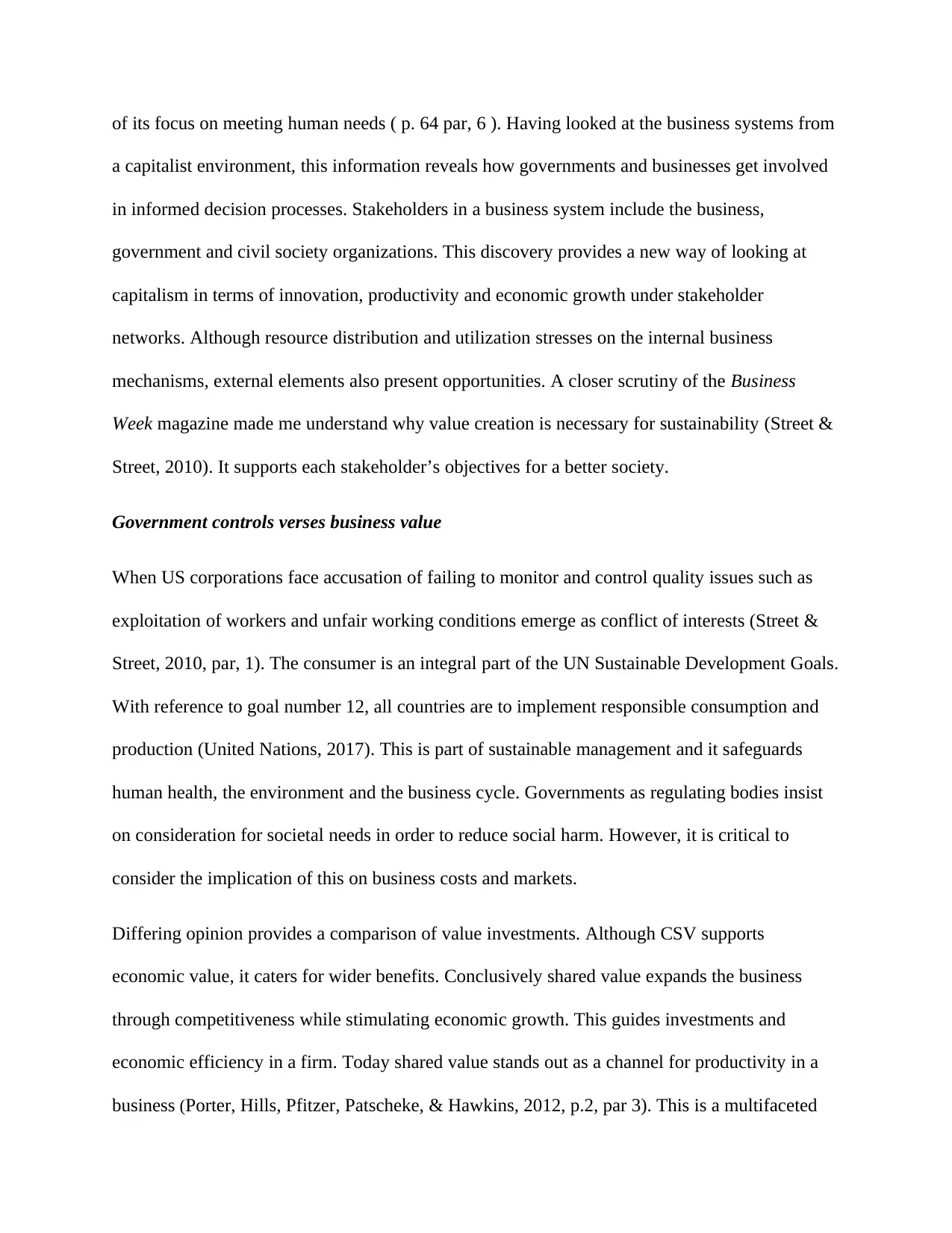
of its focus on meeting human needs ( p. 64 par, 6 ). Having looked at the business systems from
a capitalist environment, this information reveals how governments and businesses get involved
in informed decision processes. Stakeholders in a business system include the business,
government and civil society organizations. This discovery provides a new way of looking at
capitalism in terms of innovation, productivity and economic growth under stakeholder
networks. Although resource distribution and utilization stresses on the internal business
mechanisms, external elements also present opportunities. A closer scrutiny of the Business
Week magazine made me understand why value creation is necessary for sustainability (Street &
Street, 2010). It supports each stakeholder’s objectives for a better society.
Government controls verses business value
When US corporations face accusation of failing to monitor and control quality issues such as
exploitation of workers and unfair working conditions emerge as conflict of interests (Street &
Street, 2010, par, 1). The consumer is an integral part of the UN Sustainable Development Goals.
With reference to goal number 12, all countries are to implement responsible consumption and
production (United Nations, 2017). This is part of sustainable management and it safeguards
human health, the environment and the business cycle. Governments as regulating bodies insist
on consideration for societal needs in order to reduce social harm. However, it is critical to
consider the implication of this on business costs and markets.
Differing opinion provides a comparison of value investments. Although CSV supports
economic value, it caters for wider benefits. Conclusively shared value expands the business
through competitiveness while stimulating economic growth. This guides investments and
economic efficiency in a firm. Today shared value stands out as a channel for productivity in a
business (Porter, Hills, Pfitzer, Patscheke, & Hawkins, 2012, p.2, par 3). This is a multifaceted
a capitalist environment, this information reveals how governments and businesses get involved
in informed decision processes. Stakeholders in a business system include the business,
government and civil society organizations. This discovery provides a new way of looking at
capitalism in terms of innovation, productivity and economic growth under stakeholder
networks. Although resource distribution and utilization stresses on the internal business
mechanisms, external elements also present opportunities. A closer scrutiny of the Business
Week magazine made me understand why value creation is necessary for sustainability (Street &
Street, 2010). It supports each stakeholder’s objectives for a better society.
Government controls verses business value
When US corporations face accusation of failing to monitor and control quality issues such as
exploitation of workers and unfair working conditions emerge as conflict of interests (Street &
Street, 2010, par, 1). The consumer is an integral part of the UN Sustainable Development Goals.
With reference to goal number 12, all countries are to implement responsible consumption and
production (United Nations, 2017). This is part of sustainable management and it safeguards
human health, the environment and the business cycle. Governments as regulating bodies insist
on consideration for societal needs in order to reduce social harm. However, it is critical to
consider the implication of this on business costs and markets.
Differing opinion provides a comparison of value investments. Although CSV supports
economic value, it caters for wider benefits. Conclusively shared value expands the business
through competitiveness while stimulating economic growth. This guides investments and
economic efficiency in a firm. Today shared value stands out as a channel for productivity in a
business (Porter, Hills, Pfitzer, Patscheke, & Hawkins, 2012, p.2, par 3). This is a multifaceted
Paraphrase This Document
Need a fresh take? Get an instant paraphrase of this document with our AI Paraphraser
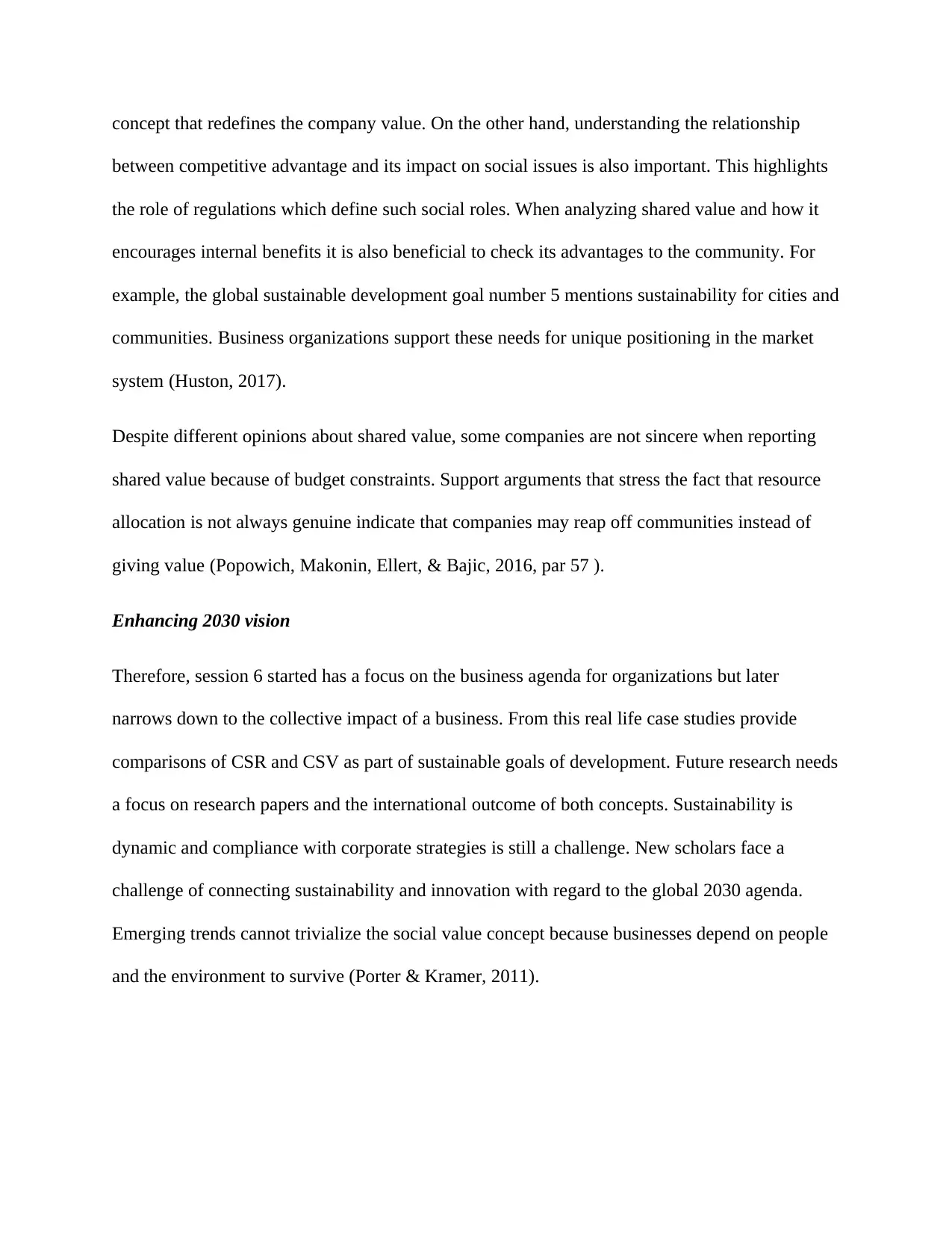
concept that redefines the company value. On the other hand, understanding the relationship
between competitive advantage and its impact on social issues is also important. This highlights
the role of regulations which define such social roles. When analyzing shared value and how it
encourages internal benefits it is also beneficial to check its advantages to the community. For
example, the global sustainable development goal number 5 mentions sustainability for cities and
communities. Business organizations support these needs for unique positioning in the market
system (Huston, 2017).
Despite different opinions about shared value, some companies are not sincere when reporting
shared value because of budget constraints. Support arguments that stress the fact that resource
allocation is not always genuine indicate that companies may reap off communities instead of
giving value (Popowich, Makonin, Ellert, & Bajic, 2016, par 57 ).
Enhancing 2030 vision
Therefore, session 6 started has a focus on the business agenda for organizations but later
narrows down to the collective impact of a business. From this real life case studies provide
comparisons of CSR and CSV as part of sustainable goals of development. Future research needs
a focus on research papers and the international outcome of both concepts. Sustainability is
dynamic and compliance with corporate strategies is still a challenge. New scholars face a
challenge of connecting sustainability and innovation with regard to the global 2030 agenda.
Emerging trends cannot trivialize the social value concept because businesses depend on people
and the environment to survive (Porter & Kramer, 2011).
between competitive advantage and its impact on social issues is also important. This highlights
the role of regulations which define such social roles. When analyzing shared value and how it
encourages internal benefits it is also beneficial to check its advantages to the community. For
example, the global sustainable development goal number 5 mentions sustainability for cities and
communities. Business organizations support these needs for unique positioning in the market
system (Huston, 2017).
Despite different opinions about shared value, some companies are not sincere when reporting
shared value because of budget constraints. Support arguments that stress the fact that resource
allocation is not always genuine indicate that companies may reap off communities instead of
giving value (Popowich, Makonin, Ellert, & Bajic, 2016, par 57 ).
Enhancing 2030 vision
Therefore, session 6 started has a focus on the business agenda for organizations but later
narrows down to the collective impact of a business. From this real life case studies provide
comparisons of CSR and CSV as part of sustainable goals of development. Future research needs
a focus on research papers and the international outcome of both concepts. Sustainability is
dynamic and compliance with corporate strategies is still a challenge. New scholars face a
challenge of connecting sustainability and innovation with regard to the global 2030 agenda.
Emerging trends cannot trivialize the social value concept because businesses depend on people
and the environment to survive (Porter & Kramer, 2011).
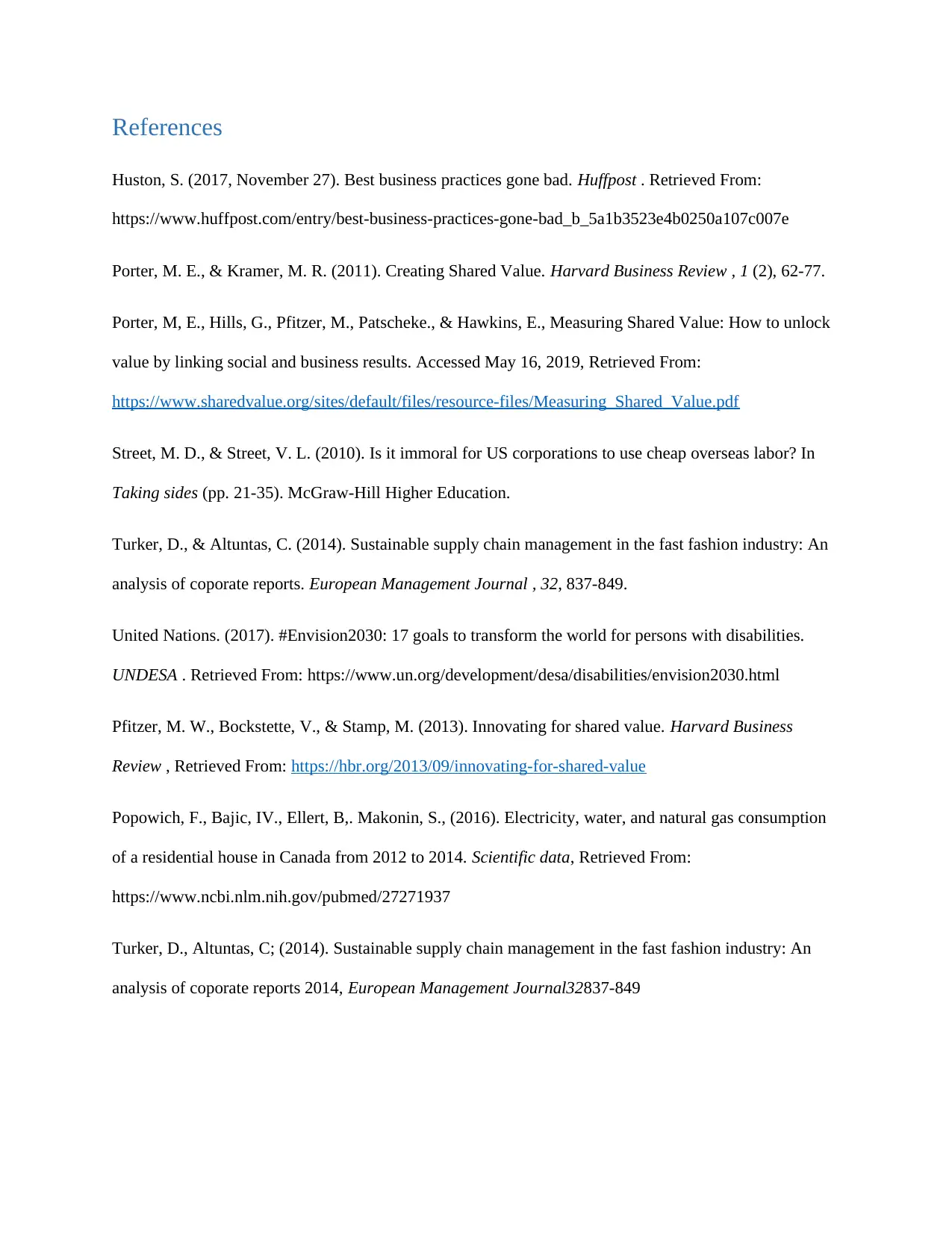
References
Huston, S. (2017, November 27). Best business practices gone bad. Huffpost . Retrieved From:
https://www.huffpost.com/entry/best-business-practices-gone-bad_b_5a1b3523e4b0250a107c007e
Porter, M. E., & Kramer, M. R. (2011). Creating Shared Value. Harvard Business Review , 1 (2), 62-77.
Porter, M, E., Hills, G., Pfitzer, M., Patscheke., & Hawkins, E., Measuring Shared Value: How to unlock
value by linking social and business results. Accessed May 16, 2019, Retrieved From:
https://www.sharedvalue.org/sites/default/files/resource-files/Measuring_Shared_Value.pdf
Street, M. D., & Street, V. L. (2010). Is it immoral for US corporations to use cheap overseas labor? In
Taking sides (pp. 21-35). McGraw-Hill Higher Education.
Turker, D., & Altuntas, C. (2014). Sustainable supply chain management in the fast fashion industry: An
analysis of coporate reports. European Management Journal , 32, 837-849.
United Nations. (2017). #Envision2030: 17 goals to transform the world for persons with disabilities.
UNDESA . Retrieved From: https://www.un.org/development/desa/disabilities/envision2030.html
Pfitzer, M. W., Bockstette, V., & Stamp, M. (2013). Innovating for shared value. Harvard Business
Review , Retrieved From: https://hbr.org/2013/09/innovating-for-shared-value
Popowich, F., Bajic, IV., Ellert, B,. Makonin, S., (2016). Electricity, water, and natural gas consumption
of a residential house in Canada from 2012 to 2014. Scientific data, Retrieved From:
https://www.ncbi.nlm.nih.gov/pubmed/27271937
Turker, D., Altuntas, C; (2014). Sustainable supply chain management in the fast fashion industry: An
analysis of coporate reports 2014, European Management Journal32837-849
Huston, S. (2017, November 27). Best business practices gone bad. Huffpost . Retrieved From:
https://www.huffpost.com/entry/best-business-practices-gone-bad_b_5a1b3523e4b0250a107c007e
Porter, M. E., & Kramer, M. R. (2011). Creating Shared Value. Harvard Business Review , 1 (2), 62-77.
Porter, M, E., Hills, G., Pfitzer, M., Patscheke., & Hawkins, E., Measuring Shared Value: How to unlock
value by linking social and business results. Accessed May 16, 2019, Retrieved From:
https://www.sharedvalue.org/sites/default/files/resource-files/Measuring_Shared_Value.pdf
Street, M. D., & Street, V. L. (2010). Is it immoral for US corporations to use cheap overseas labor? In
Taking sides (pp. 21-35). McGraw-Hill Higher Education.
Turker, D., & Altuntas, C. (2014). Sustainable supply chain management in the fast fashion industry: An
analysis of coporate reports. European Management Journal , 32, 837-849.
United Nations. (2017). #Envision2030: 17 goals to transform the world for persons with disabilities.
UNDESA . Retrieved From: https://www.un.org/development/desa/disabilities/envision2030.html
Pfitzer, M. W., Bockstette, V., & Stamp, M. (2013). Innovating for shared value. Harvard Business
Review , Retrieved From: https://hbr.org/2013/09/innovating-for-shared-value
Popowich, F., Bajic, IV., Ellert, B,. Makonin, S., (2016). Electricity, water, and natural gas consumption
of a residential house in Canada from 2012 to 2014. Scientific data, Retrieved From:
https://www.ncbi.nlm.nih.gov/pubmed/27271937
Turker, D., Altuntas, C; (2014). Sustainable supply chain management in the fast fashion industry: An
analysis of coporate reports 2014, European Management Journal32837-849
⊘ This is a preview!⊘
Do you want full access?
Subscribe today to unlock all pages.

Trusted by 1+ million students worldwide
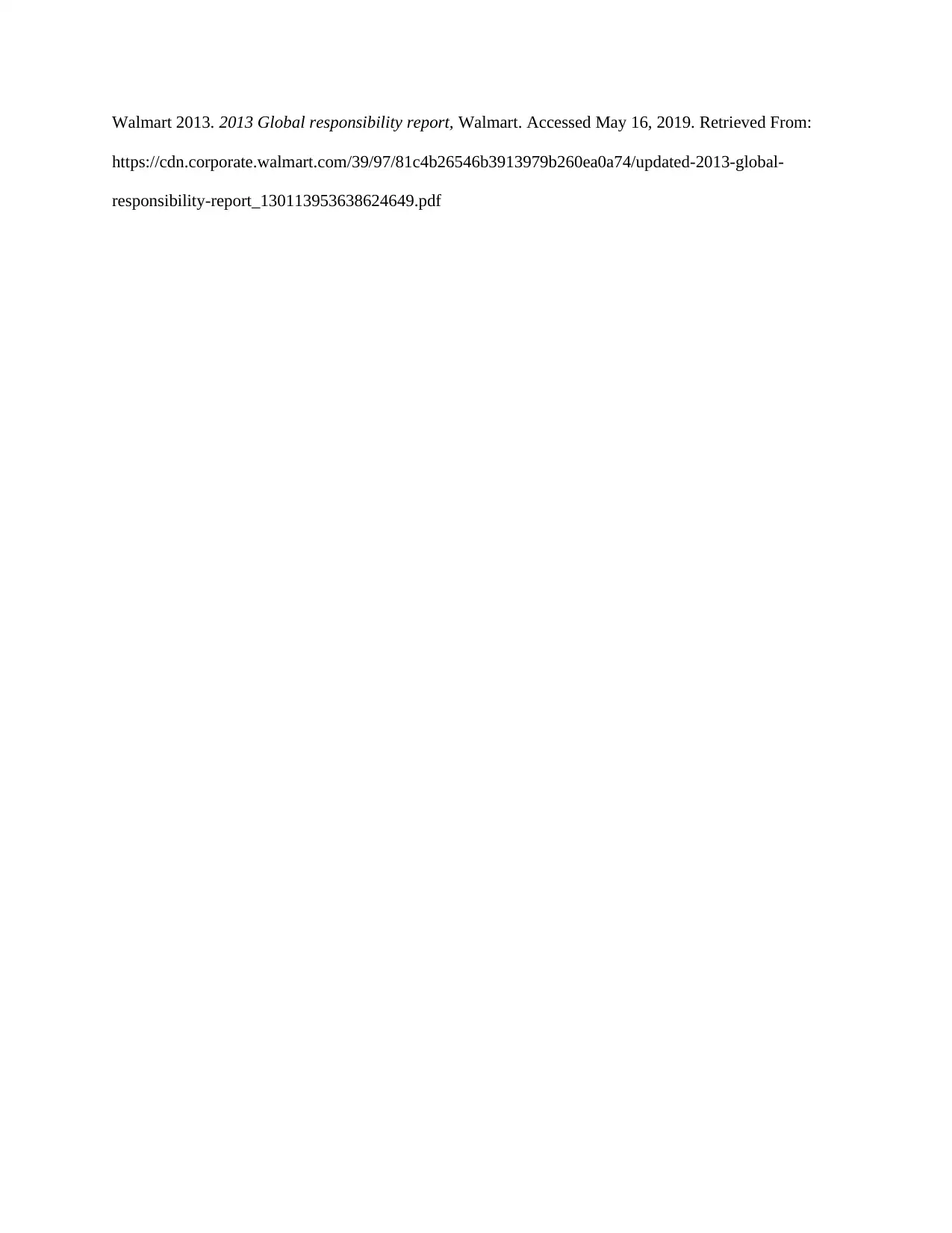
Walmart 2013. 2013 Global responsibility report, Walmart. Accessed May 16, 2019. Retrieved From:
https://cdn.corporate.walmart.com/39/97/81c4b26546b3913979b260ea0a74/updated-2013-global-
responsibility-report_130113953638624649.pdf
https://cdn.corporate.walmart.com/39/97/81c4b26546b3913979b260ea0a74/updated-2013-global-
responsibility-report_130113953638624649.pdf
Paraphrase This Document
Need a fresh take? Get an instant paraphrase of this document with our AI Paraphraser
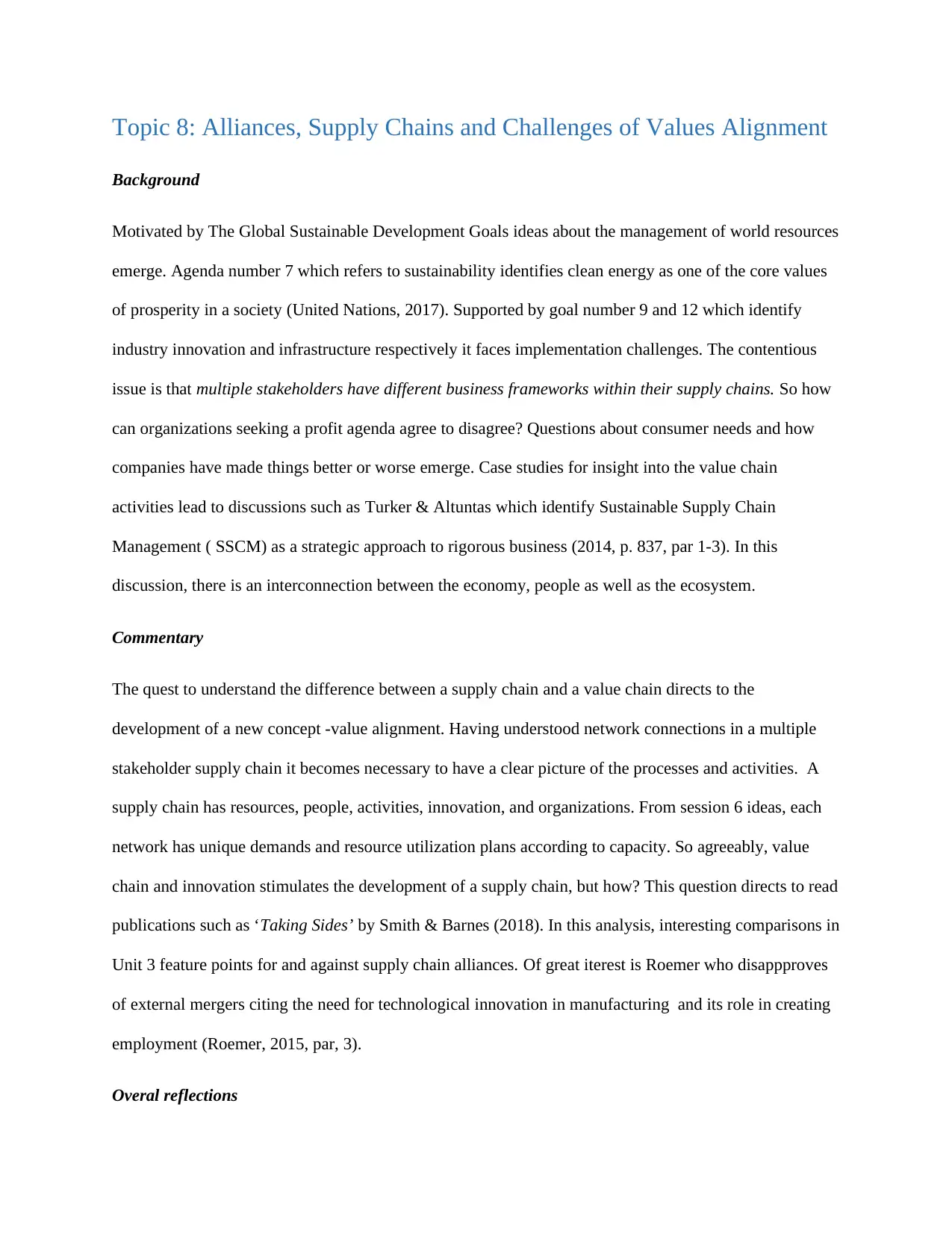
Topic 8: Alliances, Supply Chains and Challenges of Values Alignment
Background
Motivated by The Global Sustainable Development Goals ideas about the management of world resources
emerge. Agenda number 7 which refers to sustainability identifies clean energy as one of the core values
of prosperity in a society (United Nations, 2017). Supported by goal number 9 and 12 which identify
industry innovation and infrastructure respectively it faces implementation challenges. The contentious
issue is that multiple stakeholders have different business frameworks within their supply chains. So how
can organizations seeking a profit agenda agree to disagree? Questions about consumer needs and how
companies have made things better or worse emerge. Case studies for insight into the value chain
activities lead to discussions such as Turker & Altuntas which identify Sustainable Supply Chain
Management ( SSCM) as a strategic approach to rigorous business (2014, p. 837, par 1-3). In this
discussion, there is an interconnection between the economy, people as well as the ecosystem.
Commentary
The quest to understand the difference between a supply chain and a value chain directs to the
development of a new concept -value alignment. Having understood network connections in a multiple
stakeholder supply chain it becomes necessary to have a clear picture of the processes and activities. A
supply chain has resources, people, activities, innovation, and organizations. From session 6 ideas, each
network has unique demands and resource utilization plans according to capacity. So agreeably, value
chain and innovation stimulates the development of a supply chain, but how? This question directs to read
publications such as ‘Taking Sides’ by Smith & Barnes (2018). In this analysis, interesting comparisons in
Unit 3 feature points for and against supply chain alliances. Of great iterest is Roemer who disappproves
of external mergers citing the need for technological innovation in manufacturing and its role in creating
employment (Roemer, 2015, par, 3).
Overal reflections
Background
Motivated by The Global Sustainable Development Goals ideas about the management of world resources
emerge. Agenda number 7 which refers to sustainability identifies clean energy as one of the core values
of prosperity in a society (United Nations, 2017). Supported by goal number 9 and 12 which identify
industry innovation and infrastructure respectively it faces implementation challenges. The contentious
issue is that multiple stakeholders have different business frameworks within their supply chains. So how
can organizations seeking a profit agenda agree to disagree? Questions about consumer needs and how
companies have made things better or worse emerge. Case studies for insight into the value chain
activities lead to discussions such as Turker & Altuntas which identify Sustainable Supply Chain
Management ( SSCM) as a strategic approach to rigorous business (2014, p. 837, par 1-3). In this
discussion, there is an interconnection between the economy, people as well as the ecosystem.
Commentary
The quest to understand the difference between a supply chain and a value chain directs to the
development of a new concept -value alignment. Having understood network connections in a multiple
stakeholder supply chain it becomes necessary to have a clear picture of the processes and activities. A
supply chain has resources, people, activities, innovation, and organizations. From session 6 ideas, each
network has unique demands and resource utilization plans according to capacity. So agreeably, value
chain and innovation stimulates the development of a supply chain, but how? This question directs to read
publications such as ‘Taking Sides’ by Smith & Barnes (2018). In this analysis, interesting comparisons in
Unit 3 feature points for and against supply chain alliances. Of great iterest is Roemer who disappproves
of external mergers citing the need for technological innovation in manufacturing and its role in creating
employment (Roemer, 2015, par, 3).
Overal reflections
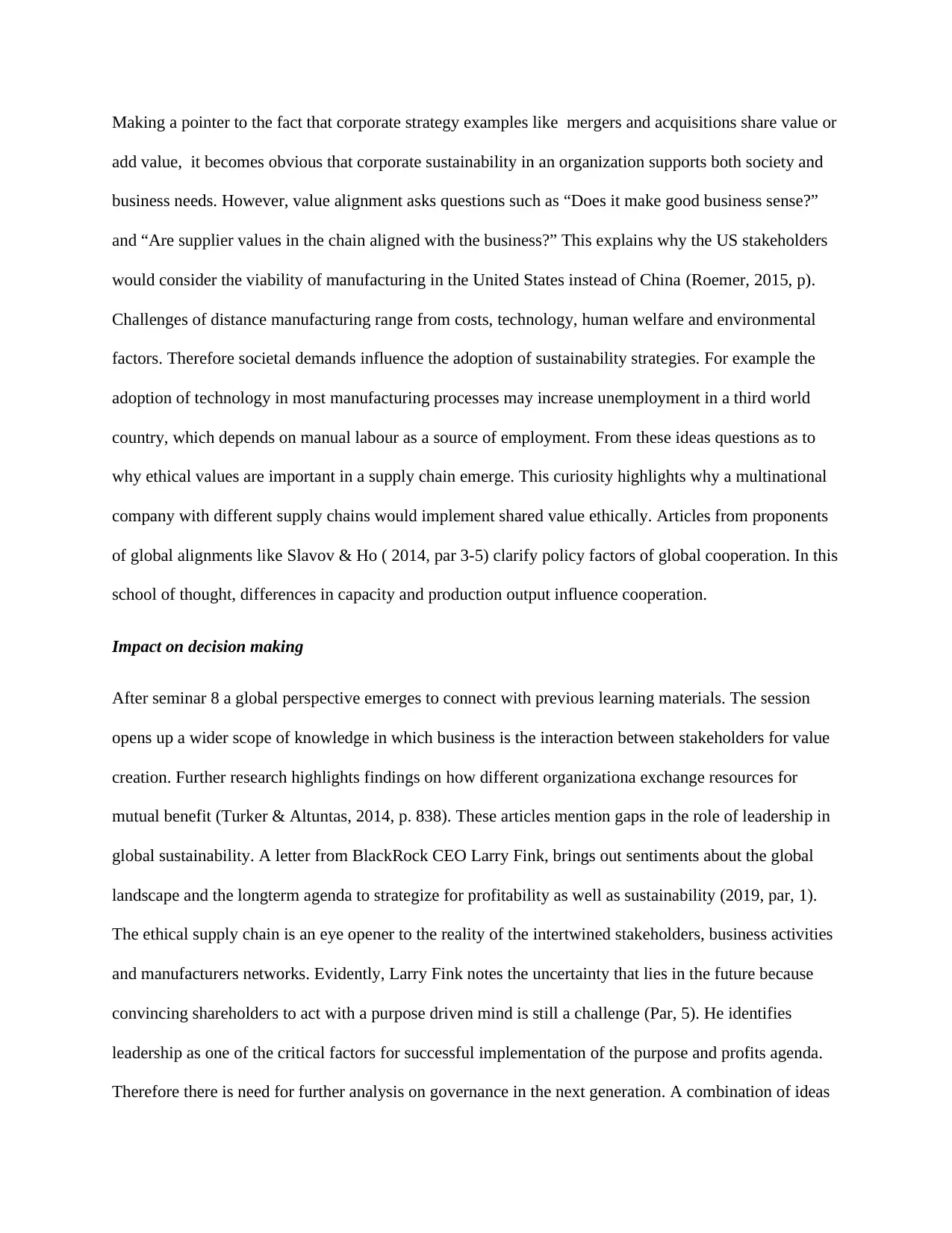
Making a pointer to the fact that corporate strategy examples like mergers and acquisitions share value or
add value, it becomes obvious that corporate sustainability in an organization supports both society and
business needs. However, value alignment asks questions such as “Does it make good business sense?”
and “Are supplier values in the chain aligned with the business?” This explains why the US stakeholders
would consider the viability of manufacturing in the United States instead of China (Roemer, 2015, p).
Challenges of distance manufacturing range from costs, technology, human welfare and environmental
factors. Therefore societal demands influence the adoption of sustainability strategies. For example the
adoption of technology in most manufacturing processes may increase unemployment in a third world
country, which depends on manual labour as a source of employment. From these ideas questions as to
why ethical values are important in a supply chain emerge. This curiosity highlights why a multinational
company with different supply chains would implement shared value ethically. Articles from proponents
of global alignments like Slavov & Ho ( 2014, par 3-5) clarify policy factors of global cooperation. In this
school of thought, differences in capacity and production output influence cooperation.
Impact on decision making
After seminar 8 a global perspective emerges to connect with previous learning materials. The session
opens up a wider scope of knowledge in which business is the interaction between stakeholders for value
creation. Further research highlights findings on how different organizationa exchange resources for
mutual benefit (Turker & Altuntas, 2014, p. 838). These articles mention gaps in the role of leadership in
global sustainability. A letter from BlackRock CEO Larry Fink, brings out sentiments about the global
landscape and the longterm agenda to strategize for profitability as well as sustainability (2019, par, 1).
The ethical supply chain is an eye opener to the reality of the intertwined stakeholders, business activities
and manufacturers networks. Evidently, Larry Fink notes the uncertainty that lies in the future because
convincing shareholders to act with a purpose driven mind is still a challenge (Par, 5). He identifies
leadership as one of the critical factors for successful implementation of the purpose and profits agenda.
Therefore there is need for further analysis on governance in the next generation. A combination of ideas
add value, it becomes obvious that corporate sustainability in an organization supports both society and
business needs. However, value alignment asks questions such as “Does it make good business sense?”
and “Are supplier values in the chain aligned with the business?” This explains why the US stakeholders
would consider the viability of manufacturing in the United States instead of China (Roemer, 2015, p).
Challenges of distance manufacturing range from costs, technology, human welfare and environmental
factors. Therefore societal demands influence the adoption of sustainability strategies. For example the
adoption of technology in most manufacturing processes may increase unemployment in a third world
country, which depends on manual labour as a source of employment. From these ideas questions as to
why ethical values are important in a supply chain emerge. This curiosity highlights why a multinational
company with different supply chains would implement shared value ethically. Articles from proponents
of global alignments like Slavov & Ho ( 2014, par 3-5) clarify policy factors of global cooperation. In this
school of thought, differences in capacity and production output influence cooperation.
Impact on decision making
After seminar 8 a global perspective emerges to connect with previous learning materials. The session
opens up a wider scope of knowledge in which business is the interaction between stakeholders for value
creation. Further research highlights findings on how different organizationa exchange resources for
mutual benefit (Turker & Altuntas, 2014, p. 838). These articles mention gaps in the role of leadership in
global sustainability. A letter from BlackRock CEO Larry Fink, brings out sentiments about the global
landscape and the longterm agenda to strategize for profitability as well as sustainability (2019, par, 1).
The ethical supply chain is an eye opener to the reality of the intertwined stakeholders, business activities
and manufacturers networks. Evidently, Larry Fink notes the uncertainty that lies in the future because
convincing shareholders to act with a purpose driven mind is still a challenge (Par, 5). He identifies
leadership as one of the critical factors for successful implementation of the purpose and profits agenda.
Therefore there is need for further analysis on governance in the next generation. A combination of ideas
⊘ This is a preview!⊘
Do you want full access?
Subscribe today to unlock all pages.

Trusted by 1+ million students worldwide
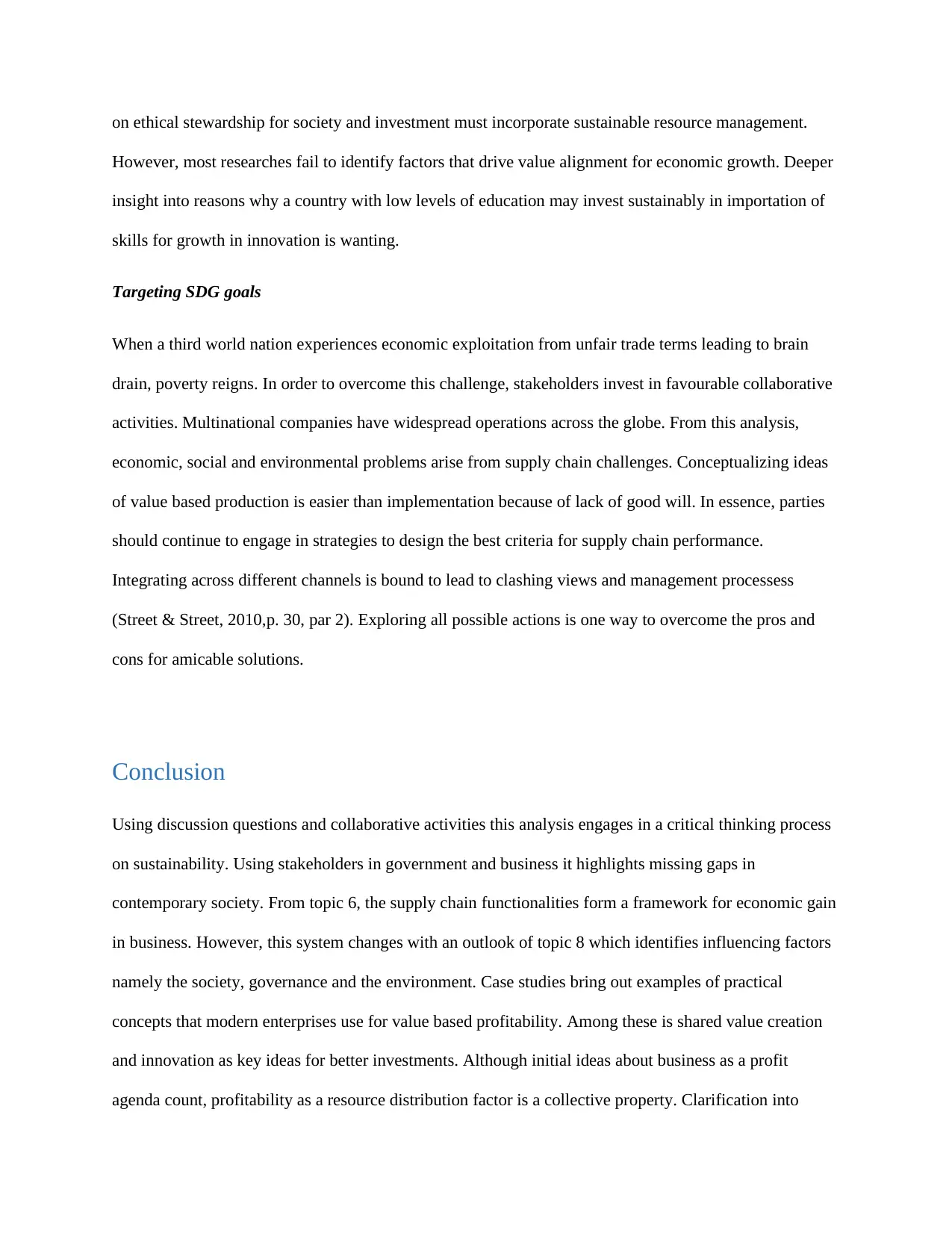
on ethical stewardship for society and investment must incorporate sustainable resource management.
However, most researches fail to identify factors that drive value alignment for economic growth. Deeper
insight into reasons why a country with low levels of education may invest sustainably in importation of
skills for growth in innovation is wanting.
Targeting SDG goals
When a third world nation experiences economic exploitation from unfair trade terms leading to brain
drain, poverty reigns. In order to overcome this challenge, stakeholders invest in favourable collaborative
activities. Multinational companies have widespread operations across the globe. From this analysis,
economic, social and environmental problems arise from supply chain challenges. Conceptualizing ideas
of value based production is easier than implementation because of lack of good will. In essence, parties
should continue to engage in strategies to design the best criteria for supply chain performance.
Integrating across different channels is bound to lead to clashing views and management processess
(Street & Street, 2010,p. 30, par 2). Exploring all possible actions is one way to overcome the pros and
cons for amicable solutions.
Conclusion
Using discussion questions and collaborative activities this analysis engages in a critical thinking process
on sustainability. Using stakeholders in government and business it highlights missing gaps in
contemporary society. From topic 6, the supply chain functionalities form a framework for economic gain
in business. However, this system changes with an outlook of topic 8 which identifies influencing factors
namely the society, governance and the environment. Case studies bring out examples of practical
concepts that modern enterprises use for value based profitability. Among these is shared value creation
and innovation as key ideas for better investments. Although initial ideas about business as a profit
agenda count, profitability as a resource distribution factor is a collective property. Clarification into
However, most researches fail to identify factors that drive value alignment for economic growth. Deeper
insight into reasons why a country with low levels of education may invest sustainably in importation of
skills for growth in innovation is wanting.
Targeting SDG goals
When a third world nation experiences economic exploitation from unfair trade terms leading to brain
drain, poverty reigns. In order to overcome this challenge, stakeholders invest in favourable collaborative
activities. Multinational companies have widespread operations across the globe. From this analysis,
economic, social and environmental problems arise from supply chain challenges. Conceptualizing ideas
of value based production is easier than implementation because of lack of good will. In essence, parties
should continue to engage in strategies to design the best criteria for supply chain performance.
Integrating across different channels is bound to lead to clashing views and management processess
(Street & Street, 2010,p. 30, par 2). Exploring all possible actions is one way to overcome the pros and
cons for amicable solutions.
Conclusion
Using discussion questions and collaborative activities this analysis engages in a critical thinking process
on sustainability. Using stakeholders in government and business it highlights missing gaps in
contemporary society. From topic 6, the supply chain functionalities form a framework for economic gain
in business. However, this system changes with an outlook of topic 8 which identifies influencing factors
namely the society, governance and the environment. Case studies bring out examples of practical
concepts that modern enterprises use for value based profitability. Among these is shared value creation
and innovation as key ideas for better investments. Although initial ideas about business as a profit
agenda count, profitability as a resource distribution factor is a collective property. Clarification into
Paraphrase This Document
Need a fresh take? Get an instant paraphrase of this document with our AI Paraphraser
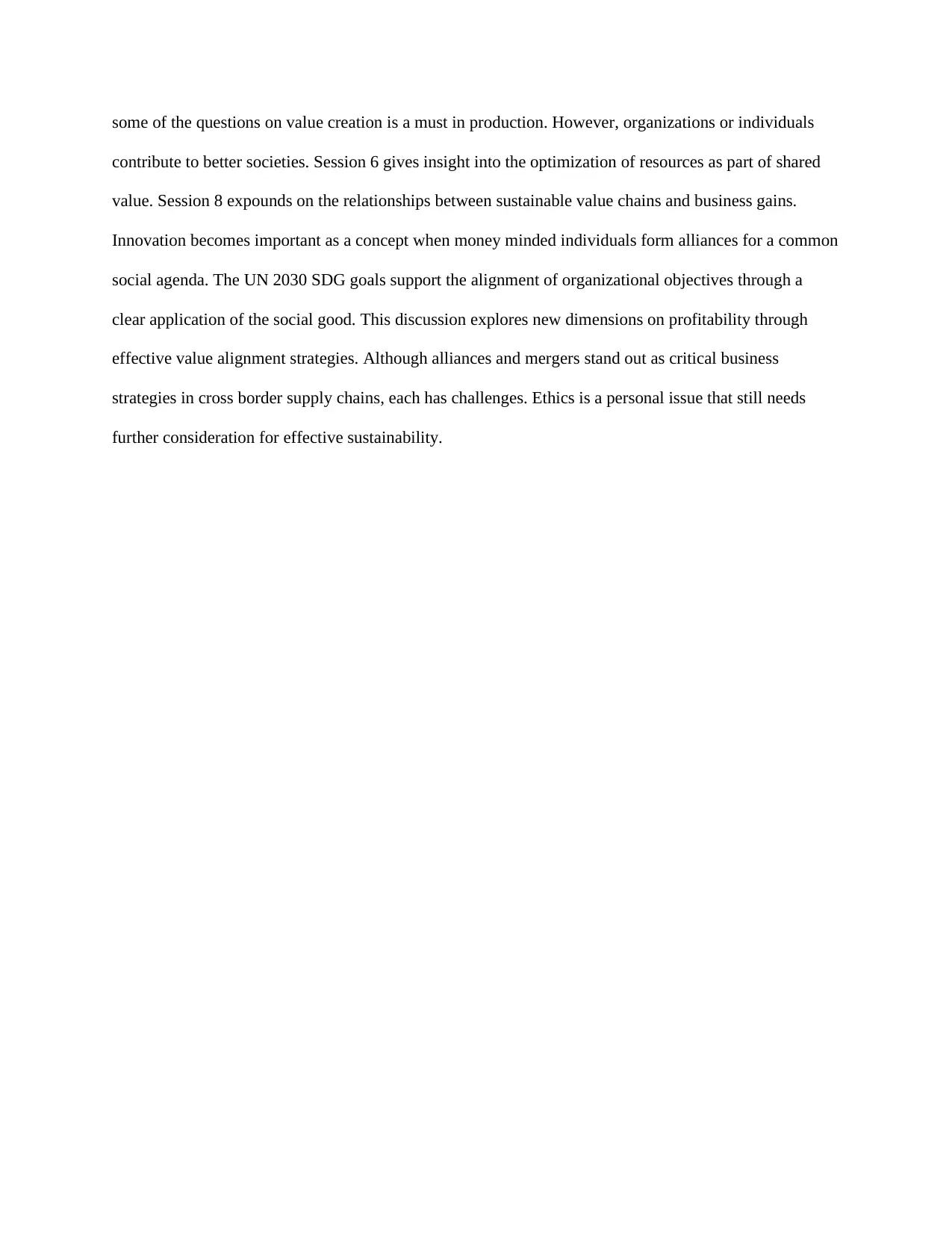
some of the questions on value creation is a must in production. However, organizations or individuals
contribute to better societies. Session 6 gives insight into the optimization of resources as part of shared
value. Session 8 expounds on the relationships between sustainable value chains and business gains.
Innovation becomes important as a concept when money minded individuals form alliances for a common
social agenda. The UN 2030 SDG goals support the alignment of organizational objectives through a
clear application of the social good. This discussion explores new dimensions on profitability through
effective value alignment strategies. Although alliances and mergers stand out as critical business
strategies in cross border supply chains, each has challenges. Ethics is a personal issue that still needs
further consideration for effective sustainability.
contribute to better societies. Session 6 gives insight into the optimization of resources as part of shared
value. Session 8 expounds on the relationships between sustainable value chains and business gains.
Innovation becomes important as a concept when money minded individuals form alliances for a common
social agenda. The UN 2030 SDG goals support the alignment of organizational objectives through a
clear application of the social good. This discussion explores new dimensions on profitability through
effective value alignment strategies. Although alliances and mergers stand out as critical business
strategies in cross border supply chains, each has challenges. Ethics is a personal issue that still needs
further consideration for effective sustainability.
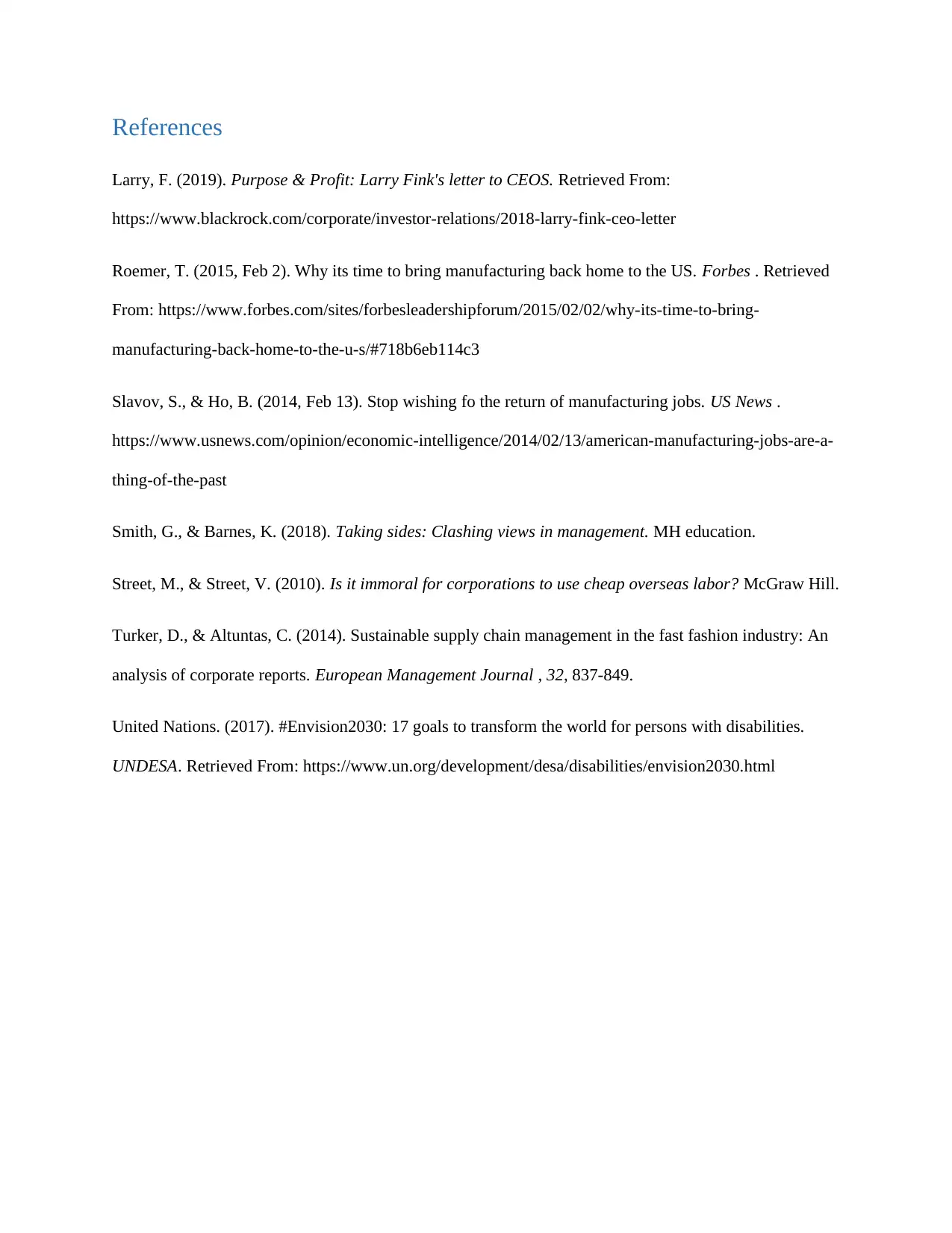
References
Larry, F. (2019). Purpose & Profit: Larry Fink's letter to CEOS. Retrieved From:
https://www.blackrock.com/corporate/investor-relations/2018-larry-fink-ceo-letter
Roemer, T. (2015, Feb 2). Why its time to bring manufacturing back home to the US. Forbes . Retrieved
From: https://www.forbes.com/sites/forbesleadershipforum/2015/02/02/why-its-time-to-bring-
manufacturing-back-home-to-the-u-s/#718b6eb114c3
Slavov, S., & Ho, B. (2014, Feb 13). Stop wishing fo the return of manufacturing jobs. US News .
https://www.usnews.com/opinion/economic-intelligence/2014/02/13/american-manufacturing-jobs-are-a-
thing-of-the-past
Smith, G., & Barnes, K. (2018). Taking sides: Clashing views in management. MH education.
Street, M., & Street, V. (2010). Is it immoral for corporations to use cheap overseas labor? McGraw Hill.
Turker, D., & Altuntas, C. (2014). Sustainable supply chain management in the fast fashion industry: An
analysis of corporate reports. European Management Journal , 32, 837-849.
United Nations. (2017). #Envision2030: 17 goals to transform the world for persons with disabilities.
UNDESA. Retrieved From: https://www.un.org/development/desa/disabilities/envision2030.html
Larry, F. (2019). Purpose & Profit: Larry Fink's letter to CEOS. Retrieved From:
https://www.blackrock.com/corporate/investor-relations/2018-larry-fink-ceo-letter
Roemer, T. (2015, Feb 2). Why its time to bring manufacturing back home to the US. Forbes . Retrieved
From: https://www.forbes.com/sites/forbesleadershipforum/2015/02/02/why-its-time-to-bring-
manufacturing-back-home-to-the-u-s/#718b6eb114c3
Slavov, S., & Ho, B. (2014, Feb 13). Stop wishing fo the return of manufacturing jobs. US News .
https://www.usnews.com/opinion/economic-intelligence/2014/02/13/american-manufacturing-jobs-are-a-
thing-of-the-past
Smith, G., & Barnes, K. (2018). Taking sides: Clashing views in management. MH education.
Street, M., & Street, V. (2010). Is it immoral for corporations to use cheap overseas labor? McGraw Hill.
Turker, D., & Altuntas, C. (2014). Sustainable supply chain management in the fast fashion industry: An
analysis of corporate reports. European Management Journal , 32, 837-849.
United Nations. (2017). #Envision2030: 17 goals to transform the world for persons with disabilities.
UNDESA. Retrieved From: https://www.un.org/development/desa/disabilities/envision2030.html
⊘ This is a preview!⊘
Do you want full access?
Subscribe today to unlock all pages.

Trusted by 1+ million students worldwide
1 out of 12
Related Documents
Your All-in-One AI-Powered Toolkit for Academic Success.
+13062052269
info@desklib.com
Available 24*7 on WhatsApp / Email
![[object Object]](/_next/static/media/star-bottom.7253800d.svg)
Unlock your academic potential
Copyright © 2020–2025 A2Z Services. All Rights Reserved. Developed and managed by ZUCOL.




